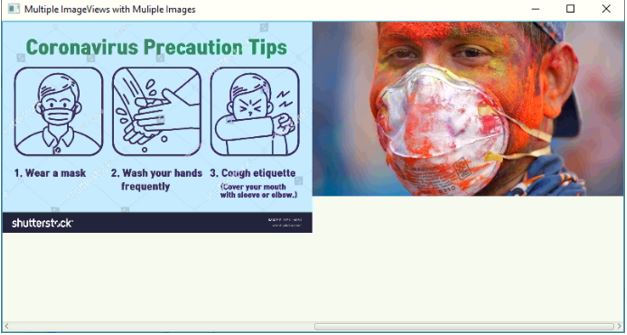

We would demonstrate this approach as well in the final demonstrative application but note that using this approach does not reduce the need of an Image instance because the run time does create an Image instance based on the url passed by us. Note that ImageView class also has a dedicated constructor which takes a String url pointing to the image: public ImageView(String url) It is noteworthy that this constructor may throw NullPointerException when the url is null it may also throw IllegalArgumentException when url is invalid or unsupported. Image imageOnLocalFileSystem = new Image("/path/to/the/image/on/filesystem")
#JAVAFX IMAGE VS IMAGEVIEWER CODE#
The very fact that we can directly pass an url gives us the flexibility not just to load image from a local file system but also to point to an image exposed on some network via its url please follow the following code snippets for illustrations: The Image class has another public single argument constructor which takes a String url. Nevertheless, once the constructor successfully executes, we would have the image loaded into memory for rendering onto the JavaFX stage. Note that this constructor can potentially throw a NullPointerException if the passed InputStream is null consequently, the calling method should take proper care of either handling this exception or re-throwing it further into the method call stack. Following code snippet illustrates this idiom:įileInputStream imageStream = new FileInputStream("/path/to/the/image") And thus any InputStream which represents a valid image can be passed to this constructor for loading that particular image. The Image class has a variety of overloaded public constructors, one of them takes an InputStream as an argument.

There are a variety of easy ways for loading an image via the Image class, however, there is a caveat: not all images can be represented in-memory via the Image instance only BMP, GIF, JPEG, PNG are valid formats as of now.įollowing are two of the most frequently used mechanisms of loading an image via the Image class: 2.1 InputStream The in-memory representation of any image is, as mentioned earlier, is through an instance of the Image class.

First Things First: Load the ImageĪny image that has to be rendered on a JavaFX stage must be first loaded into memory. We would be using JavaFX API version 8 from JDK 8. An instance of ImageView class does not merely renders images loaded instance of class, but also provides a variety of flexible manipulations to control various aspects of image rendering in this post we are going to have a look at them. Note the double slashes \\ in the string constant to escape the \ character.JavaFX exposes easy-to-use API for painting images on its stage via the class. "\\C:\\ProgramFiles\\ImageViewer\\someTiff.tif", but it worked both with and without the leading \ for me. You could place a \ at the beginning of the local image path, e.g.

("Image loading error? " + image.isError()) Image image = new Image("file:" + localImagePath.toString()) I've spent a bit of time on this and I think my problem lies in one of two places: I have specified the file path incorrectly (though this is the only variation that doesn't throw an exception), OR I have incorrectly formed the UI components and something isn't attaching to the scene/stage.Įven if someone can tell me definitively which of the two it is it would be a great help, then I'm only diving down one rabbit hole.Ī new stage will automatically size itself to it's content, so although it does no harm, you don't need the calls:Ĭheck and see if there was an error loading the image: When the new stage appears it is completely empty. ImageGroup.getChildren().add(theImageView) Scene imageScene = new Scene(imageGroup) ImageView theImageView = new ImageView(theImage) Image theImage = new Image("file:" + localImagePath.toString()) localImagePath is something like: "C:\ProgramFiles\ImageViewer\someTiff.tif" First the context - I've written a program to list TIFF files and make them viewable in a little popup window. I'm a bit new to Java and JavaFX, so I'm sure this is an easy fix.


 0 kommentar(er)
0 kommentar(er)
